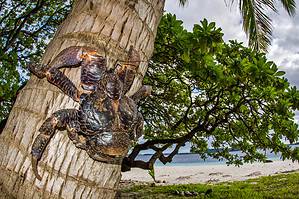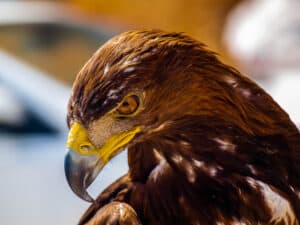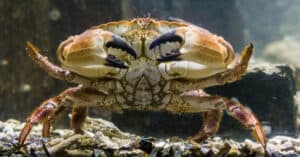Many animals are called sand fleas, but the only ones referred to as ‘jumbo sand fleas’ are really mole crabs. Mole crabs are a genus of crustaceans with hundreds of species. They burrow in the sand and filter feed using their antennae. Jumbo sand fleas are easy to find as long as you know where to look. Follow along to discover more about jumbo sand fleas, including where and how to find them.
What Are Jumbo Sand Fleas?
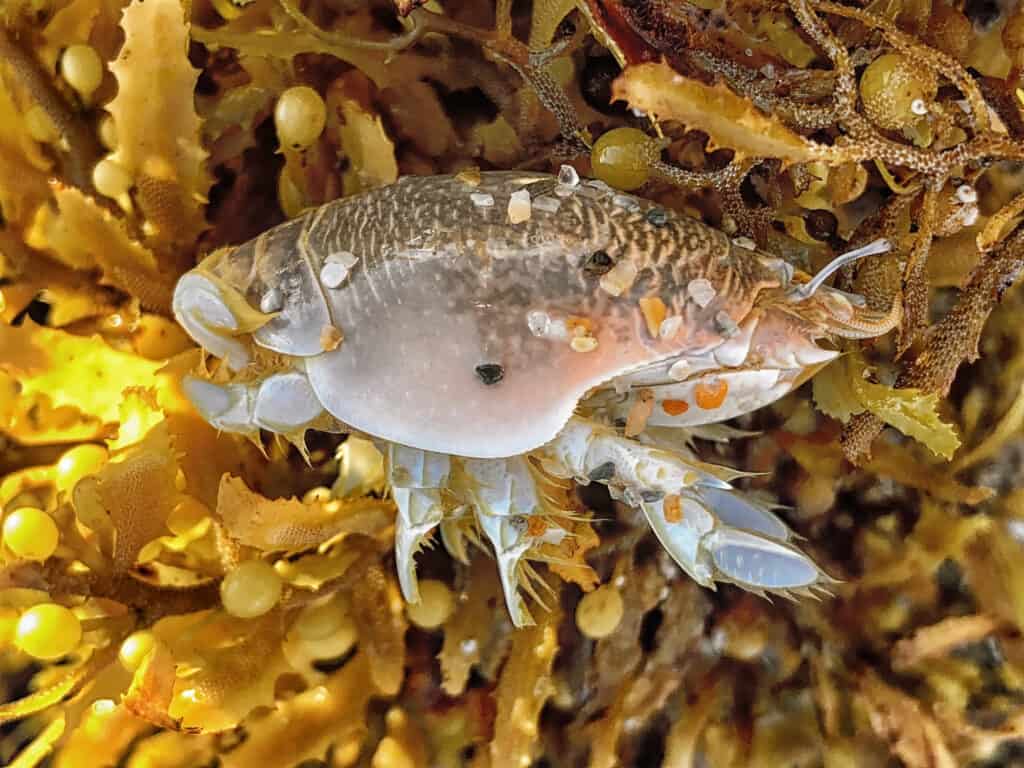
Jumbo sand fleas are just regular
mole
crabs that are larger and thicker.
©jaimie tuchman/Shutterstock.com
Jumbo sand fleas are very common in Florida and other warm coastal places in the world. Sand fleas are also called sand crabs. They are small crustaceans that burrow like a flea, however; they don’t bite humans. Jumbo sand fleas are just regular mole crabs that are larger and thicker. The larger the sand flea, the more flavorful it is. Not only are the larger sand fleas best for cooking, but they are easier to use as bait. Jumbo sand fleas can reach up to 4 inches long. However, most sand fleas are small, growing no more than 2 inches long and 1 inch wide. Female jumbo sand fleas are larger than male sand fleas since they carry many bright orange eggs. There are also ten recognized mole crab species.
Where Are Jumbo Sand Fleas Found?
There are then species of mole crabs, and they all live in different places. For example, the Pacific mole crab can be found anywhere along the Pacific. It lives in the warm sands of North and South America. However, the Emerita austroafricana is a newer species found on the coast of southeastern Africa and Madagascar. Although most jumbo sand fleas are found in North and South America, some species, like the Emerita emeritus, is native to South Asia and Southeast Asia.
How Do You Find Big Sand Fleas?
Big sand fleas are everywhere, but they hide well underneath the sand. There are multiple methods to find and catch sand fleas. Jumbo sand fleas live in the shallow surf. You can identify them by their long antennae that stick out of the sand. They burrow with their tails first, leaving their head closer to the water. While it’s not required, you can use special tools like a sand flea rake to look for large sand fleas. To do this, go to where the ocean meets the sand on the beach. Although some jumbo sand fleas bury themselves in the sand alone, the majority live in large colonies. They leave behind ‘v’ lines in the sand while feeding and digging.
A quick piece of advice for you is to look for the largest ‘v’ lines; this is where you will find the biggest colonies. When the ocean recedes, you should see their bodies exposed. Slowly and carefully bend down into the sand and use the rake to dig and scoop as fast as possible. They can sense when you are close to them and can bury themselves deeper. You can use a shovel, but the digging end can’t be too hard if you want to catch sand fleas alive. As soon as you scoop them out, place the jumbo sand fleas in a large container or bucket. If you want to use jumbo sand fleas as bait, it’s best to look for female sand fleas with bright orange eggs underneath their bodies. This orange is thought to attract fish.
Do Large Sand Fleas Bite?
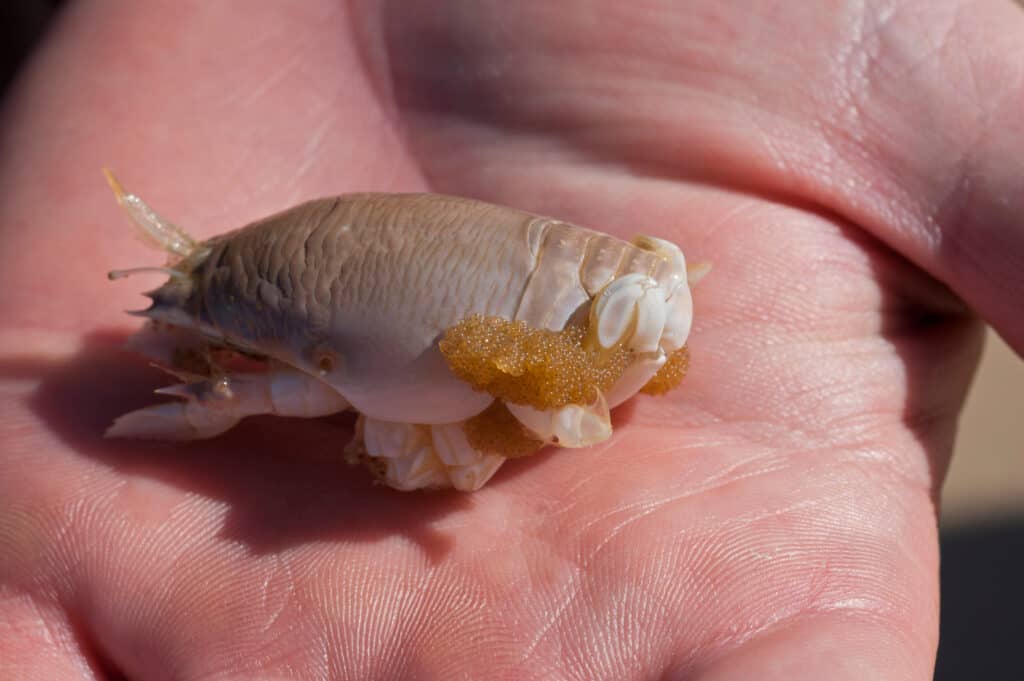
Jumbo sand fleas can’t walk. They only have short limbs for burrowing and swimming.
©Catherine Eckert/Shutterstock.com
Thankfully, you have nothing to worry about. Large sand fleas, also known as jumbo mole crabs or sand crabs, don’t bite! They don’t have pinchers either. Jumbo sand fleas can’t walk. They only have short limbs for burrowing and swimming. Instead, large sand fleas are more likely to be bitten and eaten by predators like pompano fish and humans.
Other Fun Facts About Jumbo Sand Fleas
- The best time to look for jumbo sand fleas is at night or early morning before the sun rises. Jumbo sand fleas use the darkness as protection from predators.
- If you don’t want to use live jumbo sand fleas when you catch them for bait, you can freeze them, but you need to prepare them well.
- To freeze jumbo sand fleas for bait, you need to boil the sand fleas for about 5 minutes before freezing them. This makes it easier to place them on a hook.
- From a side glance, jumbo sand fleas look like fleas, even though they are not insects.
- Jumbo sand fleas mainly consume phytoplankton and other small organisms.
- Sand fleas are very quick and can fully burrow themselves in the sand in about 1-7 seconds.
- Females during February–October, the reproductive season, produce up to 45,000 eggs per month.
- The mole crab makes up 90% of the barred surfperch’s diet.
Up Next:
- New Study: Stop Boiling Your Lobsters! Crustaceans Can Feel Pain
- What Do Krill Eat? Food for Tiny Crustaceans
- What Do Seahorses Eat? 15+ Foods They Crave
The photo featured at the top of this post is © IrinaK/Shutterstock.com
Sources
- LiMPETS, Available here: https://limpets.org/wp-content/uploads/2015/01/PacificMoleCrabFS_Oct2010.pdf
- Loyola University New Orleans, Available here: https://lucec.loyno.edu/natural-history-writings/mole-crabs#:~:text=They%20do%20not%20bite%20or,slide%20back%20into%20the%20sea.
Thank you for reading! Have some feedback for us? Contact the AZ Animals editorial team.



